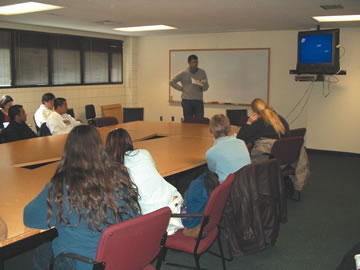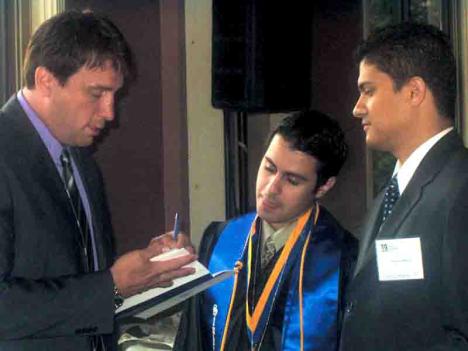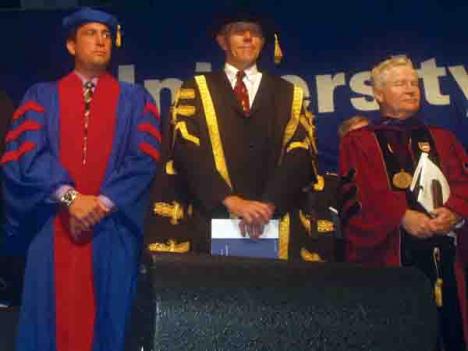Viva la “Khalsa”

March 28, 2003
On Wednesday, March 19, Professor Gautam Premnath screened the seminal socialist documentary, “Time to Rise,” by the controversial Indian filmmaker, Anand Patwardhan. “Time to Rise” is a frankly sympathetic look at the efforts of Indian Sikhs in Canada to form an agricultural union in the face of stubborn opposition.
Shot in British Columbia, Canada in 1980, the film intersperses interviews and scenes of worker agitation and marches. The film catches the bleak life of immigrant workers in rural Canada and the bitterness of the farmers and job contractors who feel squeezed by market forces no less than the field hands. Patwardhan made the film with Canadian activist Bill Munro and in partnership with the National Film Board of Canada, which has a long history of backing unknown and underappreiciated filmmakers.
Patwardhan’s film is alive with touches of humanity and humor despite its grim subject matter. One scene drew giggles from the audience, when an Indian man handing out union flyers roped in a harried Chinese man by explaining that he had flyers in Chinese, “No problem!” The Canadian Farm Workers Union has had a troubled existence since its halcyon days in the early eighties, but the good cheer with which its first members undertook its formation is unmistakable.
The difficulties that the Indians, nearly all Sikhs from the Punjab region of northwest India, faced in motivating a multiethnic, largely non-English speaking body of workers are daunting, and Patwardhan, with an adulatory eye, solves their problems by showing us the legendary Cesar Chavez, whose fierce pride and fearless demeanor helped organize the United Farm Workers union, and who has traveled to Canada to share his experience with the South Asian farm workers. Chavez has become an icon of revolutionary movements since then, traveling the world to help fledgling unions organize and bolstering support for worker’s rights. Professor Premnath explained that Patwardhan had been involved in activism since his days as a student at Bombay University, and that Patwardhan’s own involvement with the UFW had led him to Canada. This background helps explain why Chavez, certainly a prominent figure in U.S. labor, occupies a more central role in “Time to Rise” that perhaps he deserves.
Professor Premnath also helped the audience to understand the context of Indian political activities. Traditionally a self-reliant and independent bunch, the Sikhs have a long history of activism in India and in the United States. The film shows a startling cheerfulness on the part of the immigrants to do battle whenever necessary. One magnificently bearded gentleman, gazing at his vandalized automobile, calmly placed his hands on his son’s shoulders and explained, “If we had been warned, they would not have gotten away.”
“We are all ready to die,” he added with a grim twinkle in his eye. The source of this sense of community and pride is Khalsa, a Sikh word that embodies duty, solidarity and family support. Equal parts religious philosophy and political commitment “Viva la Khalsa” became the rallying cry for the CFWU, echoing Cesar Chavez’s militant slogan of previous decades, “Viva la Casa!”
The film makes no effort to be even-handed with the two enemies of the farm workers, the farmers, who own the land and provide the jobs, and the labor contractors, Indian middlemen who round up workers by school bus every morning and take a share of the worker’s pay.
Sam Drediger, a mushroom farmer and former mayor of Langley, British Columbia, is adamant is his rejection of the union, declaring, “We don’t need that kind of baloney. They can scream until they’re hoarse.”
Although the racial dimensions of the film are omnipresent, they don’t overwhelm this raw, vibrant piece of filmmaking. Aside from the expected villainous whites, we get a nice cross section of villainous Indians and another comic turn as white union workers and Indians have an awkward meeting sitting on the grass on a sunny day, discussing strategy and plans for unionizing. The whites grip their Molson beer bottles like reassuring totems of normalcy, and the Indians sit uncomfortably in traditional grab, torn between apprehension and relief.
The documentary ends with a scene of marching farm workers, who entice an old woman out of the fields to dance and march with them; she sings traditional chants and leads them down the road, a moment of naked human hope and solidarity that underscores Patwardhan’s rise to prominence as a documentary filmmaker. He won the Silver Dove (Leipzig, 1981) for this documentary and is best known for “War and Peace” about the nuclear arms race and war between Pakistan and India. “War and Peace” took home many jury awards and sent Patwardhan on a worldwide screening tour.
No lunch was served at this event. The reviewer regrets this greatly, though as it happened, the film was quite enough to chew on.






















































